The influence of genre-Based activitieson students’ foreign language writing
The findings from recent studies ofgenres and genre-related issues reveal that learners’ genre
awareness couldenhance their linguistic knowledgeandtheir language skills as well (Cheng, 2006;Johns,
2015). Students’ awareness of various genres may allow them to produce texts of different genres, many
of which would potentially appear in their future job contexts. In this study, genre-based activities were
employed in an English linguistic class. During seven weeks, the students, after being lectured on
linguistic contents, practiced the linguistic knowledege and skills they learned through genre analysis
activities and then follow-up activities. In the mid-term and end-term assignments, students were
required to produce two texts of one and the same genre. The texts that students produced were then
compared in terms of the agreement between language choices and communicative purposes to specify
the changes in their English writing; observations and informal discussion were also conducted.
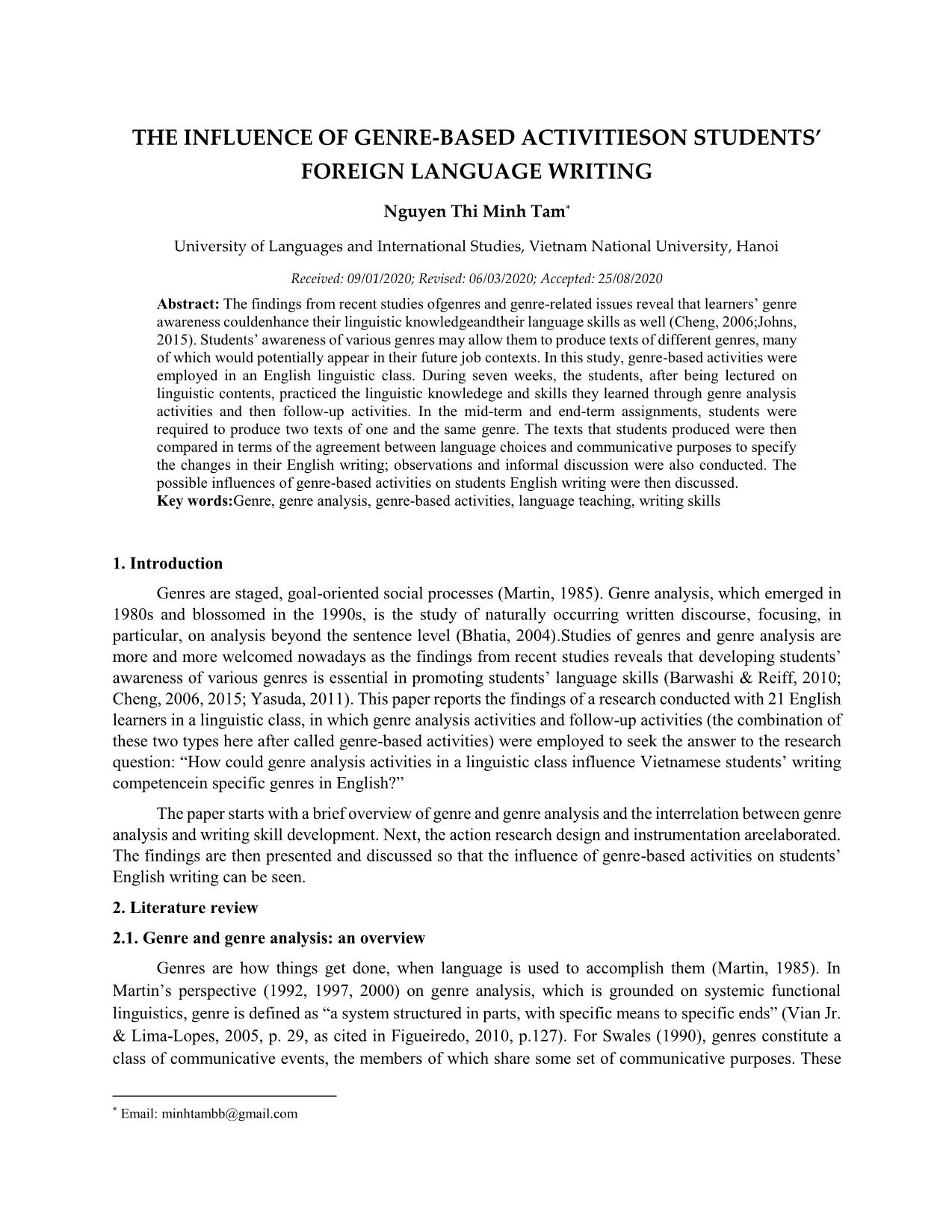
Trang 1
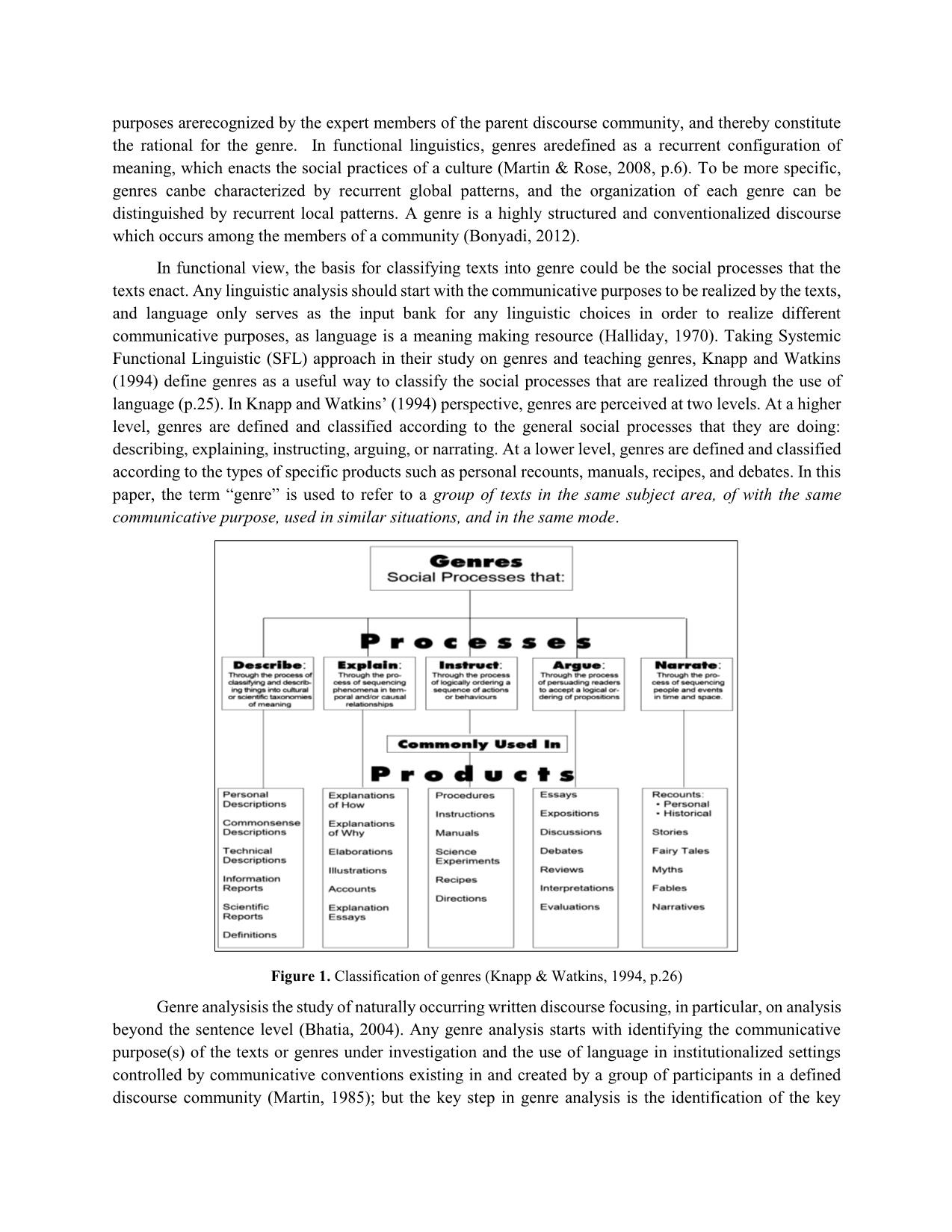
Trang 2
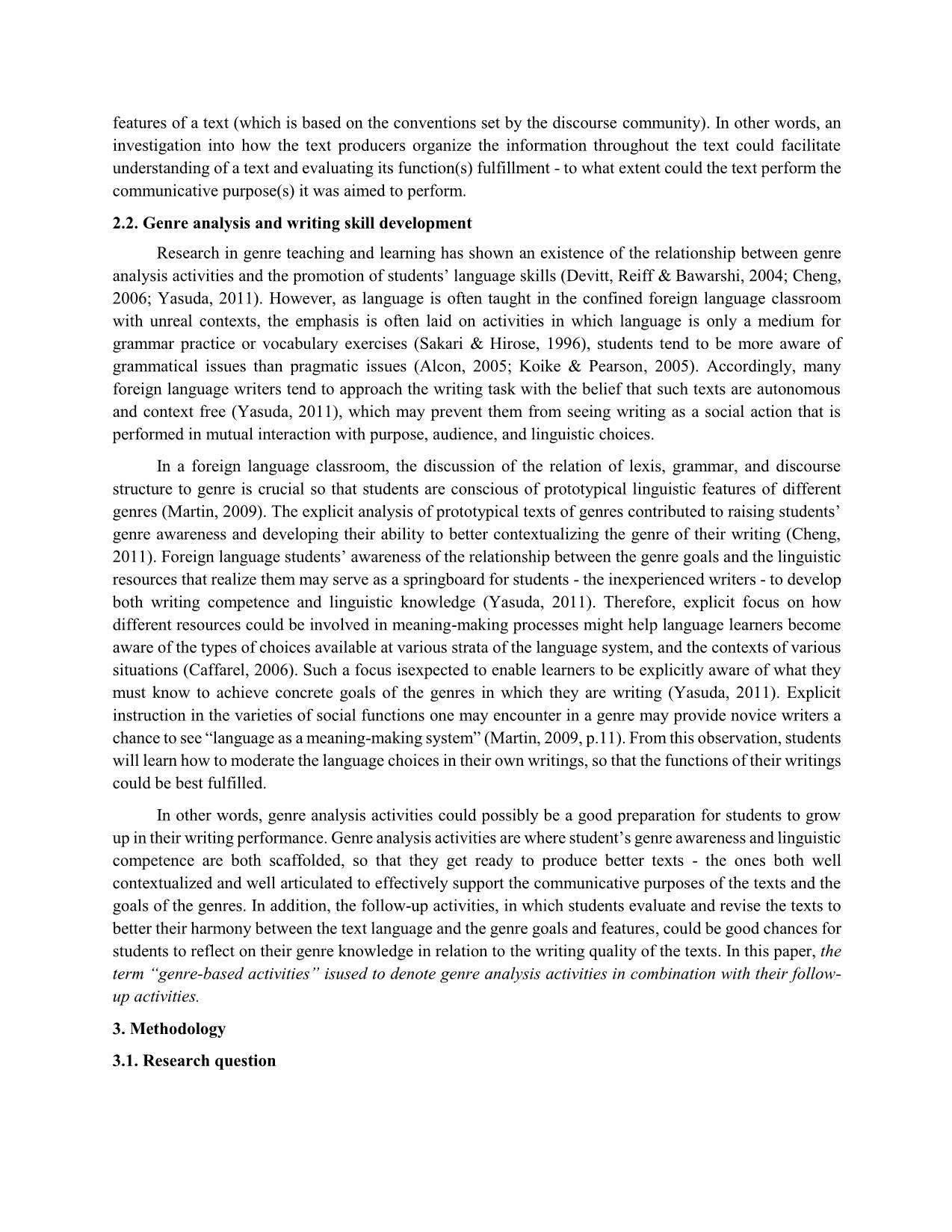
Trang 3
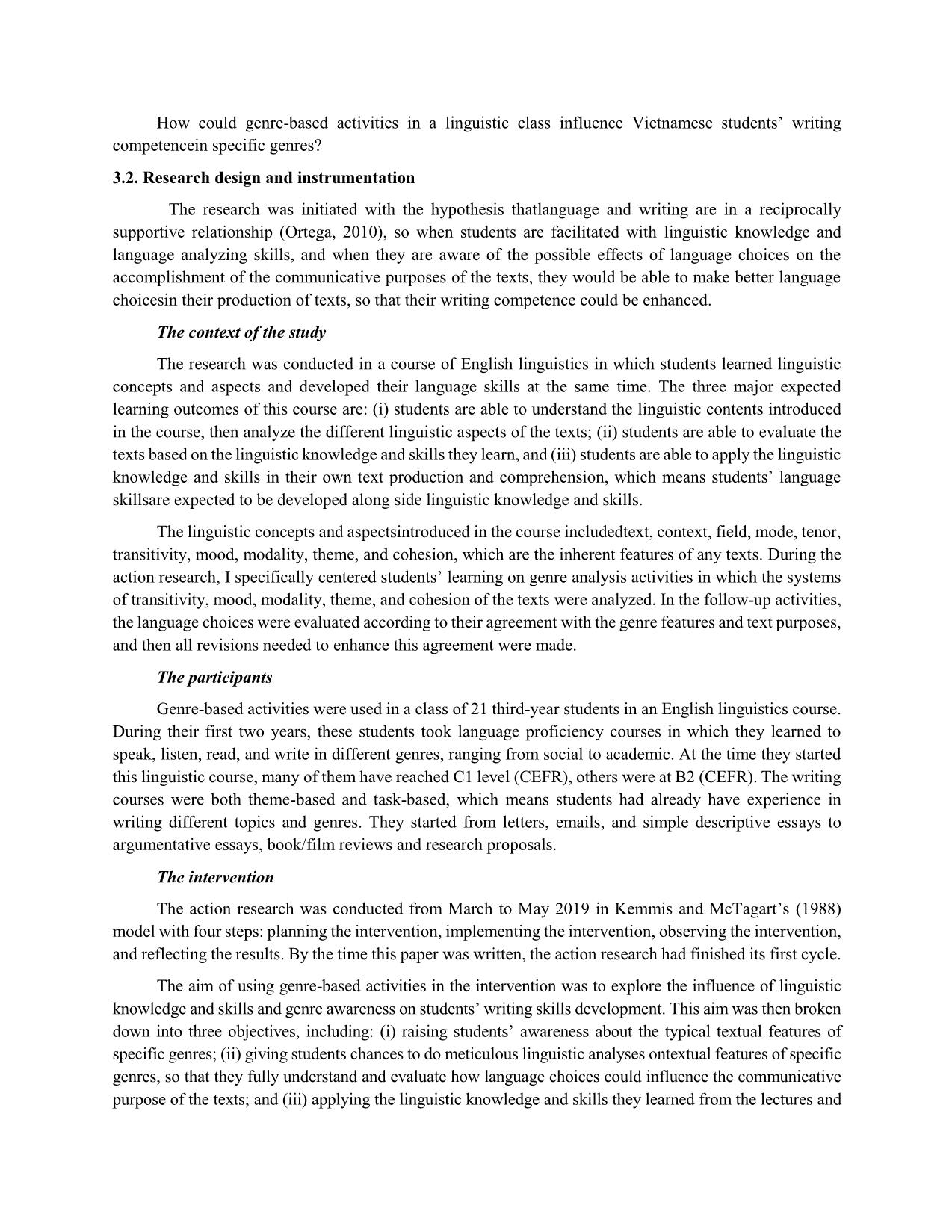
Trang 4
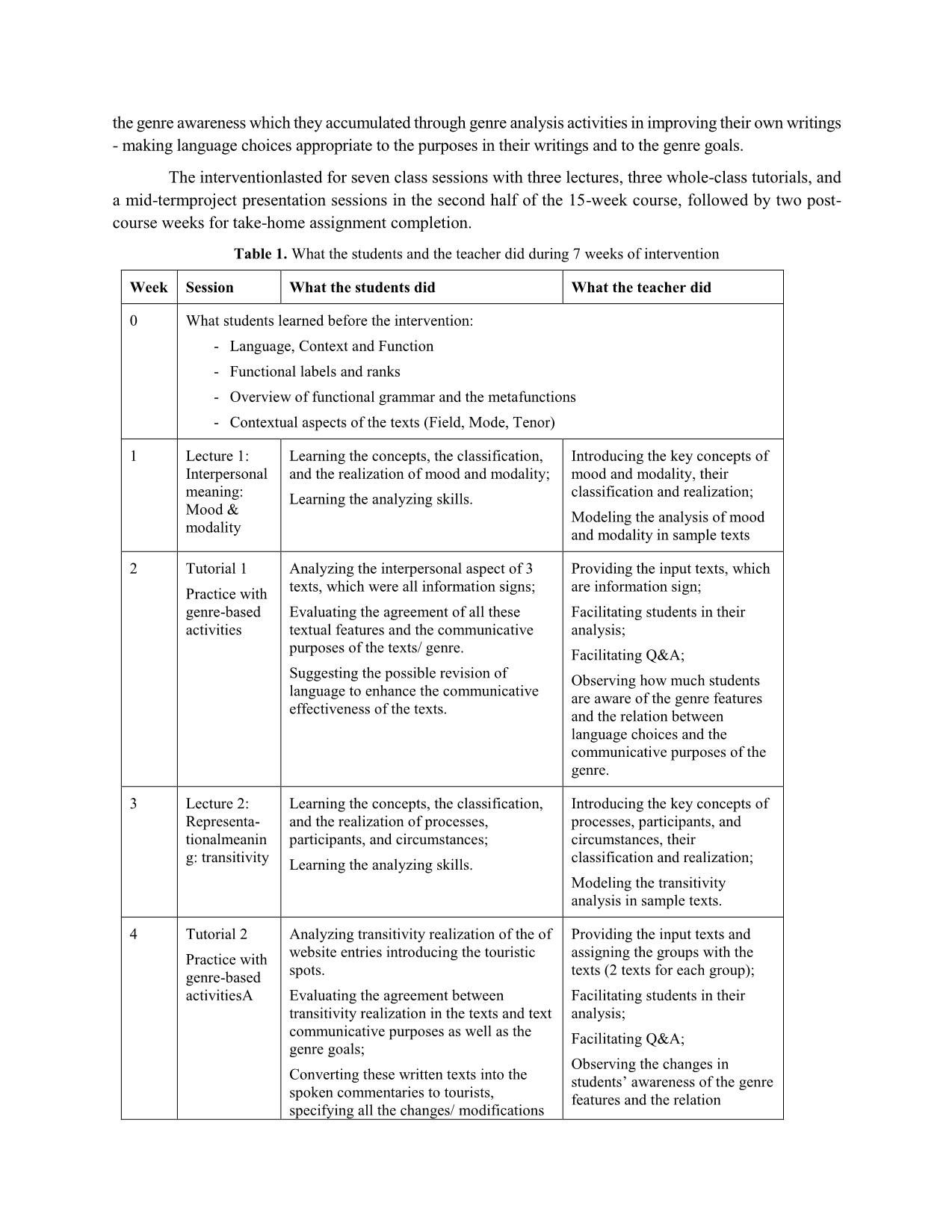
Trang 5
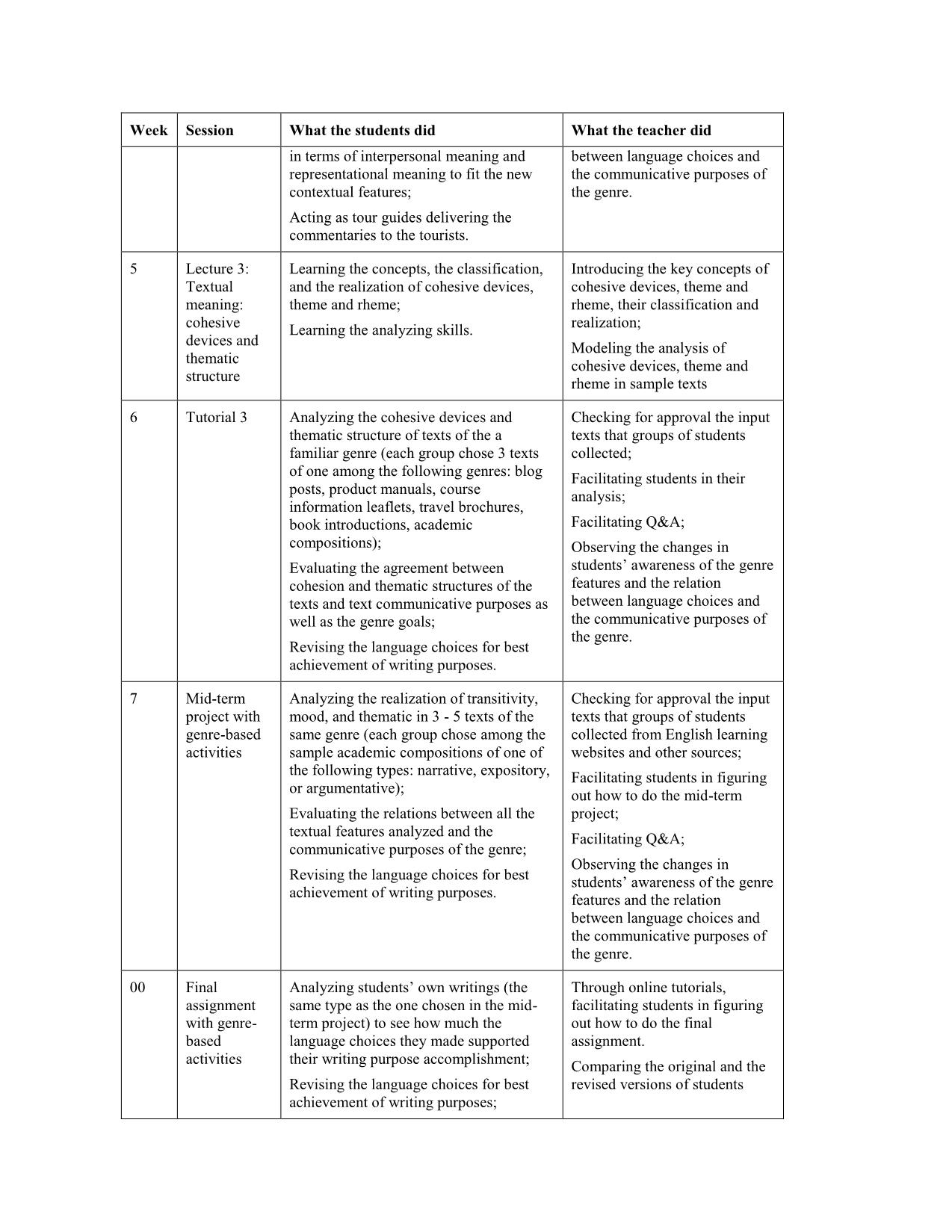
Trang 6
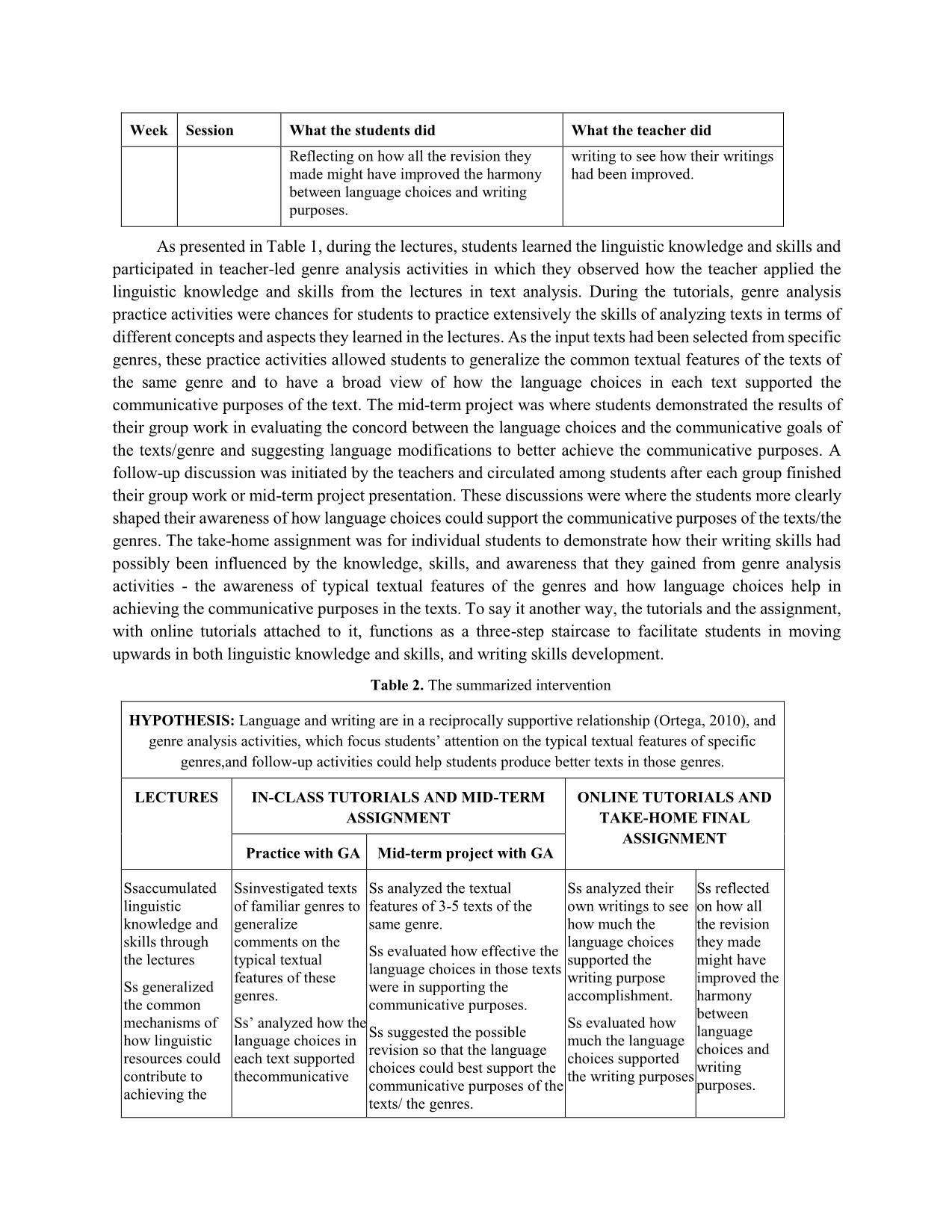
Trang 7
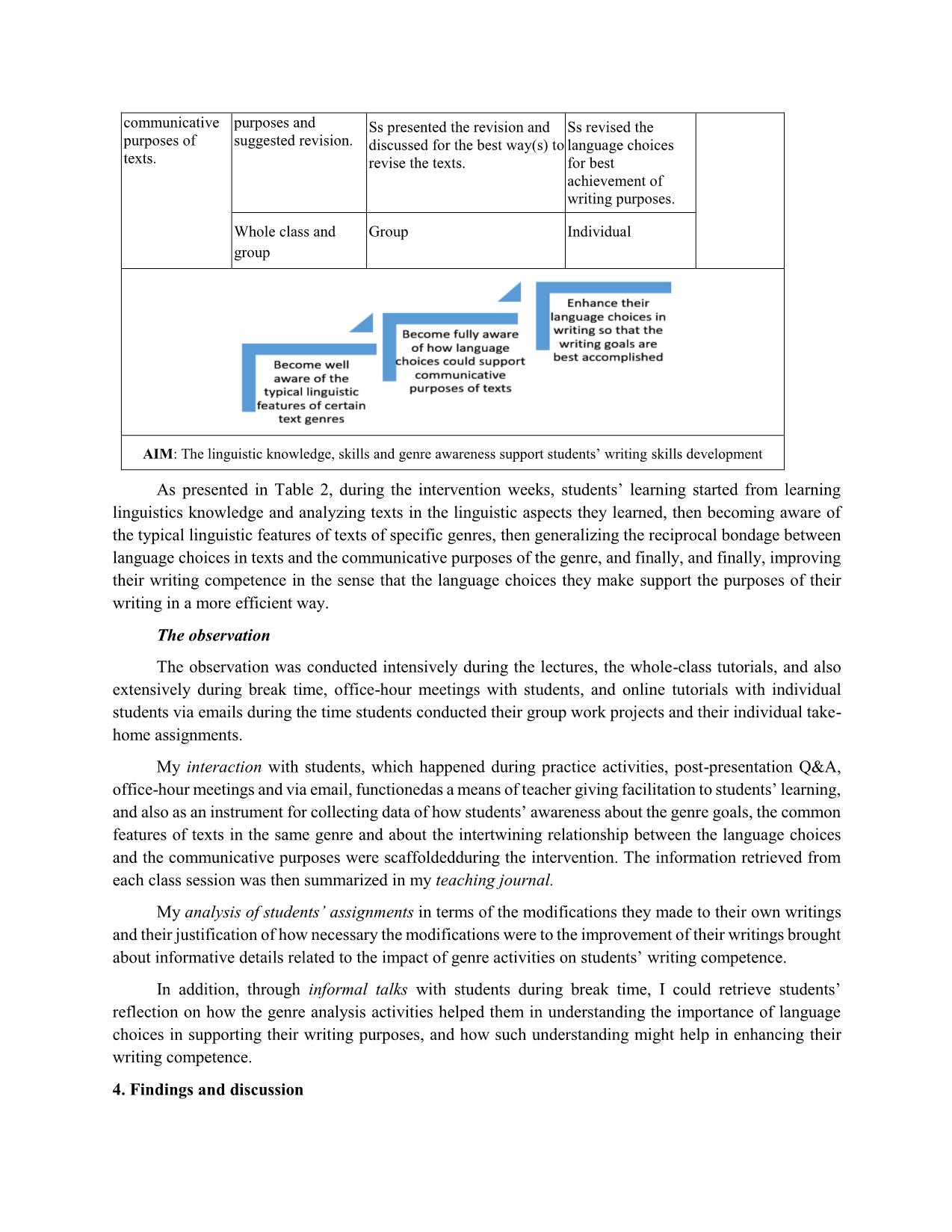
Trang 8
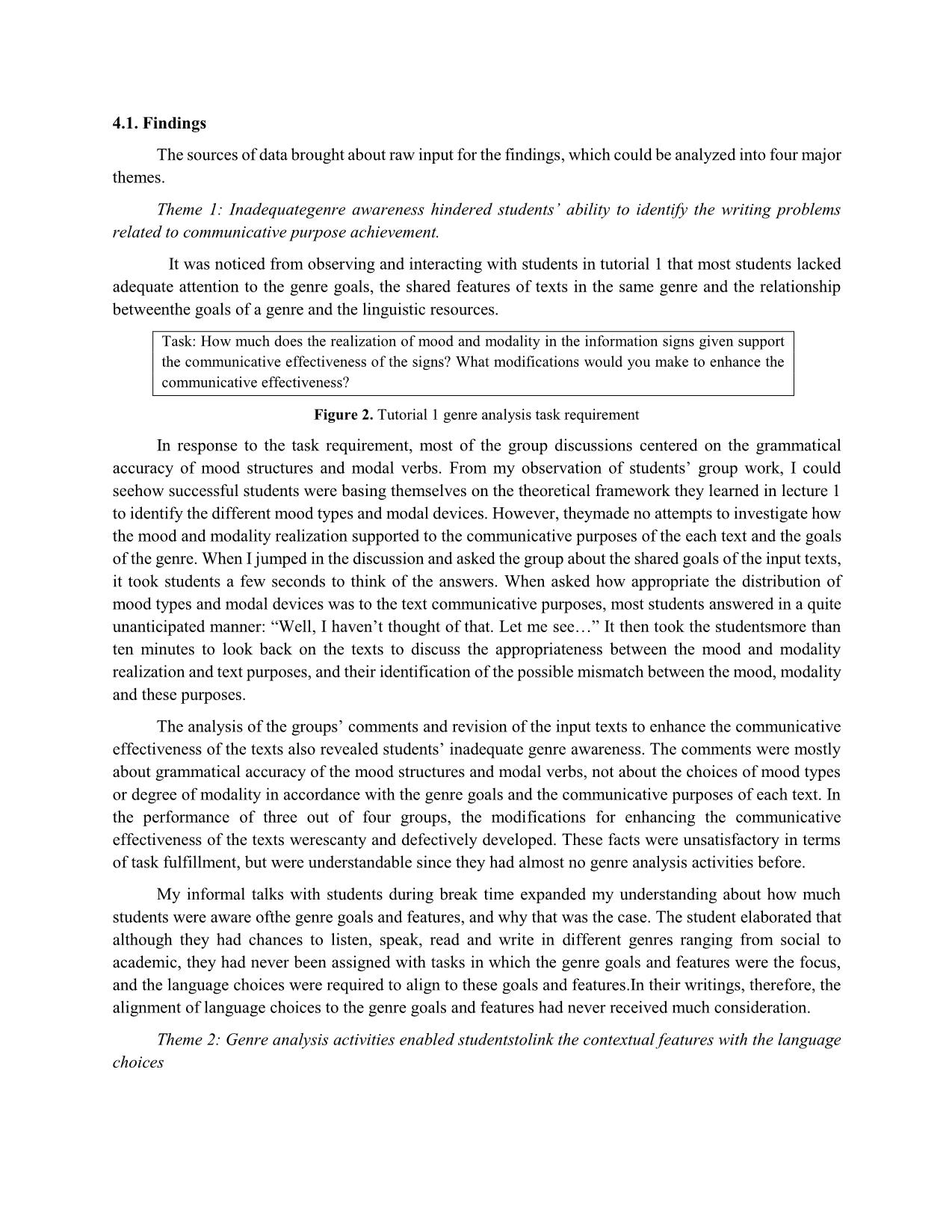
Trang 9
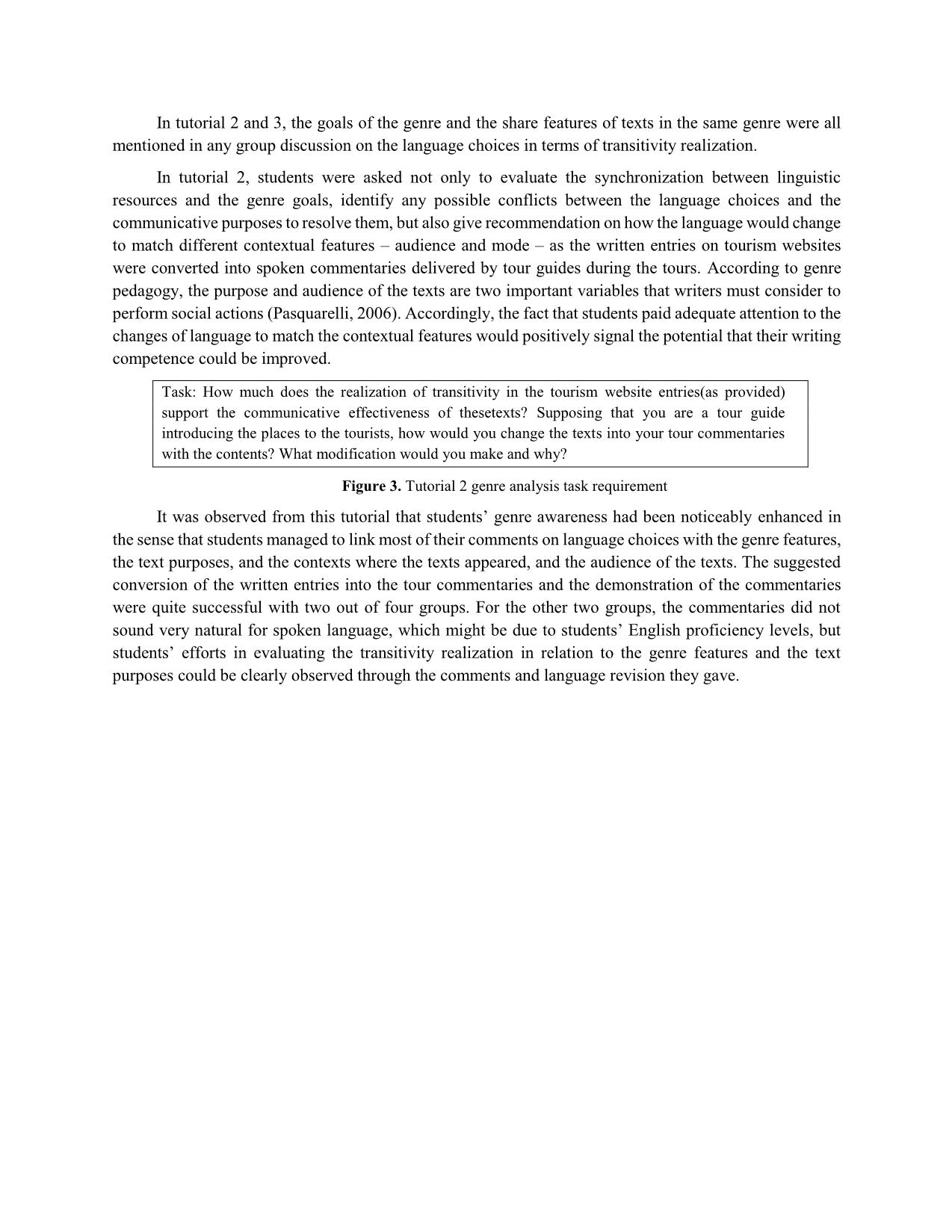
Trang 10
Tải về để xem bản đầy đủ
Tóm tắt nội dung tài liệu: The influence of genre-Based activitieson students’ foreign language writing
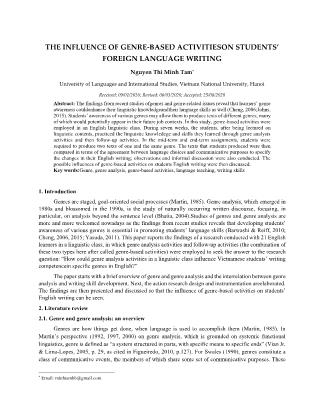
THE INFLUENCE OF GENRE-BASED ACTIVITIESON STUDENTS’ FOREIGN LANGUAGE WRITING Nguyen Thi Minh Tam* University of Languages and International Studies, Vietnam National University, Hanoi Received: 09/01/2020; Revised: 06/03/2020; Accepted: 25/08/2020 Abstract: The findings from recent studies ofgenres and genre-related issues reveal that learners’ genre awareness couldenhance their linguistic knowledgeandtheir language skills as well (Cheng, 2006;Johns, 2015). Students’ awareness of various genres may allow them to produce texts of different genres, many of which would potentially appear in their future job contexts. In this study, genre-based activities were employed in an English linguistic class. During seven weeks, the students, after being lectured on linguistic contents, practiced the linguistic knowledege and skills they learned through genre analysis activities and then follow-up activities. In the mid-term and end-term assignments, students were required to produce two texts of one and the same genre. The texts that students produced were then compared in terms of the agreement between language choices and communicative purposes to specify the changes in their English writing; observations and informal discussion were also conducted. The possible influences of genre-based activities on students English writing were then discussed. Key words:Genre, genre analysis, genre-based activities, language teaching, writing skills 1. Introduction Genres are staged, goal-oriented social processes (Martin, 1985). Genre analysis, which emerged in 1980s and blossomed in the 1990s, is the study of naturally occurring written discourse, focusing, in particular, on analysis beyond the sentence level (Bhatia, 2004).Studies of genres and genre analysis are more and more welcomed nowadays as the findings from recent studies reveals that developing students’ awareness of various genres is essential in promoting students’ language skills (Barwashi & Reiff, 2010; Cheng, 2006, 2015; Yasuda, 2011). This paper reports the findings of a research conducted with 21 English learners in a linguistic class, in which genre analysis activities and follow-up activities (the combination of these two types here after called genre-based activities) were employed to seek the answer to the research question: “How could genre analysis activities in a linguistic class influence Vietnamese students’ writing competencein specific genres in English?” The paper starts with a brief overview of genre and genre analysis and the interrelation between genre analysis and writing skill development. Next, the action research design and instrumentation areelaborated. The findings are then presented and discussed so that the influence of genre-based activities on students’ English writing can be seen. 2. Literature review 2.1. Genre and genre analysis: an overview Genres are how things get done, when language is used to accomplish them (Martin, 1985). In Martin’s perspective (1992, 1997, 2000) on genre analysis, which is grounded on systemic functional linguistics, genre is defined as “a system structured in parts, with specific means to specific ends” (Vian Jr. & Lima-Lopes, 2005, p. 29, as cited in Figueiredo, 2010, p.127). For Swales (1990), genres constitute a class of communicative events, the members of which share some set of communicative purposes. These * Email: minhtambb@gmail.com purposes arerecognized by the expert members of the parent discourse community, and thereby constitute the rational for the genre. In functional linguistics, genres aredefined as a recurrent configuration of meaning, which enacts the social practices of a culture (Martin & Rose, 2008, p.6). To be more specific, genres canbe characterized by recurrent global patterns, and the organization of each genre can be distinguished by recurrent local patterns. A genre is a highly structured and conventionalized discourse which occurs among the members of a community (Bonyadi, 2012). In functional view, the basis for classifying texts into genre could be the social processes that the texts enact. Any linguistic analysis should start with the communicative purposes to be realized by the texts, and language only serves as the input bank for any linguistic choices in order to realize different communicative purposes, as language is a meaning making resource (Halliday, 1970). Taking Systemic Functional Linguistic (SFL) approach in their study on genres and teaching genres, Knapp and Watkins (1994) define genres as a useful way to classify the social processes that are realized through the use of language (p.25). In Knapp and Watkins’ (1994) perspective, genres are perceived at two levels. At a higher level, genres are defined and classified according to the general social processes that they are doing: describing, explaining, instructing, arguing, or narrating. At a lower level, genres are defined and classified according to the types of specific products such as personal recounts, manuals, recipes, and debates. In this paper, the term “genre” is used to refer to a group of texts in the same subject area, of with the same communicative purpose, used in similar situations, and in the same mode. Figure 1. Classification of genres (Knapp & Watkins, 1994, p.26) Genre analysisis the study of naturally occurring written discourse focusing, in particular, on analysis beyond the sentence level (Bhatia, 2004). Any genre analysis starts with identifying the communicative purpose(s) of the texts or genres under investigation and the use of language in institutionalized settings controlled by communicative conventions existing in and created by a group of participants in a defined discourse community (Martin, 1985); but the key step in genre analysis is the identification of the key features of a text (which is based on the conventions set by the disco ... ur tour commentaries with the contents? What modification would you make and why? Figure 3. Tutorial 2 genre analysis task requirement It was observed from this tutorial that students’ genre awareness had been noticeably enhanced in the sense that students managed to link most of their comments on language choices with the genre features, the text purposes, and the contexts where the texts appeared, and the audience of the texts. The suggested conversion of the written entries into the tour commentaries and the demonstration of the commentaries were quite successful with two out of four groups. For the other two groups, the commentaries did not sound very natural for spoken language, which might be due to students’ English proficiency levels, but students’ efforts in evaluating the transitivity realization in relation to the genre features and the text purposes could be clearly observed through the comments and language revision they gave. Figure 4. An example of students' comments on the texts As could be seen in Figure 4, suggestions of adding new elements/details to the texts, or adding lead- in parts were popular. Many clauses of existential processes were changed into material processes. Many mental process clauses were changed from the “like” types to the “please” types. Verbal processes were inserted with projecting/quotation clauses. Some declarative mood clauses were converted into interrogative mood clauses (into rhetorical questions) for the sake of engaging the audience in the commentaries. In tutorial 3, students chose the texts of one genre among, but not limited to, those in the suggested list. The texts were chosen at their preference and convenience, so students seemed to be more confident and interested in the task than in the other two tutorials. Task: How much does the realization of thematic structure and cohesive devices in the blog posts/ product manuals/ course information leaflets / travel brochures / book introductions / academic compositions support the communicative effectiveness of thesetexts?What modifications would you make to enhance the communicative effectiveness? Figure 5. Tutorial 3 genre analysis task requirement With their experience in genre analysis activities in the previous tutorials, most groups became more confident in their analysis. Students not only modified the small details at clause levels (use another cohesive devices or change the thematic structures of the clauses), but they became more ambitious in their attempts to rewrite the texts, with major revision suggested to above-clause level in the texts. The language choices were revised in a much more creative way including changing the thematic progression in the texts or employing grammatical metaphors to enhance the cohesion of the texts. Almost no teacher-student interaction was needed in this tutorial, but students’ task fulfillment was remarkably productive. In my informal talks with students, I found that once students become aware of the possible influence of language choices in fulfilling the functions of the texts, they became more critical about all details related to the interpersonal, ideational, and textual aspects of the texts. As they accumulated more and more understanding of the linguistic features through the lectures, and more experience of applying those linguistic contents through genre analysis activities, the amount of modification they made and the level of complexity of the modification gradually increased. Theme 3: Genre-based assignments enablestudents to be more sensitive to the mismatch between language and the writing purposes, to self-assess and thus enhance their own writings. In the mid-term assignment, groups of students were required to analyze 3 to 5 sample academic compositions in one academic genre in terms of their mood, transitivity, and theme system. In the final assignment, individual students were required to choose one of their own writing of the identical genres that they analyzed in the mid-term assignment to analyze and revised. Students also had to reflect on the problems of the original writing and how much the revision changed their own writings. The analysis of the assignment disclosed a remarkable improvement in students’ writings in all three aspects: interpersonal, ideational, and textual. More than 90% of the rewritten texts (19 out of 21) were much improved in cohesion, communicative effectiveness, and tone. There seemed to be a detailed analysis of all the factors of audience, purpose, and genre features of the writings so that the revision could resolve most of the conflicts between the language and those factors in the original writings. The modifications that students made to their own writing mostly enhanced the communicative effectiveness, the tone, and the cohesion of the texts; and students were happy about what they did to improve their own writings. Figure 6. Samples of students’ reflection Such reflections as shown in Figure 6 above demonstratethat students were able to self-assess their writing, point out the problems, and make meaningful improvement. Although two out of 21 students did not achieve good improvement in their revised version, the constructive impactof genre-based activities on their writing skill development was visible. 4.2. Discussion From the findings above, it isevident that after being aware of the reciprocal relation between language choices and communicative purposes in the genre analysis activities, students were able to link the genre features and contextual features with the language choices - making language choices appropriate to the purposes in their writings and to the genre goals. The follow-up activities of genre analysis were the chances for students to apply their understanding of the features of different genres in text evaluating - spotting out the mismatch between the language choices and the communicative purposes and seeking better way to enhance the concordance between them. In other words, genre-based assignments provided students chances to reflect on the overall quality of their own writing, so the constructive impacts of genre- based activities on students writing skill development were observed. This finding echoes the reports by Cheng (2015) that genre analysis activities could facilitate learners’ noticing and learning genre-specific features and the underpinning purposes of those features. As seen through students’ task completion during the tutorials, the mid-term and end-term assignments, the complexity level of students’ linguistic features analyses and their text modification suggestions increased. What could beinferred from this observation is: genre-based activities were a good preparation for students in revising the existing texts and producing good texts of their own. This finding also supports Yasuda’s (2011)conclusion that genre-based tasks in foreign language classrooms could result in clear gains in some aspect of their writing performance, as well as their genre knowledge development. In addition, the analysis of students’ assignment papers demonstrated a quite remarkable improvement in students’ writings in different aspects of texts, which entailed that: once students’ genre awareness was emphasized, students’ ability to identify the writing problems related to communicative purpose achievement was improved, their ability to self-assess and better their own writings could be enhanced. 5. Conclusion The genre-based activities were used in a linguistic class of third-year English-major studentsto explore the influence of linguistic knowledge and skills and genre awareness on students’ writing skills development. After the lectures and tutorials in which genre analysis activities, followed by writing evaluation and revision activities as follow-up activities, were employed, students were found to gradually build up their capability of applying their linguistic understanding of different genres in evaluating and revising texts. There was evidence that student’s ability to self-assess their writingswas improved, and the enhancement of their writing skills followed. In conclusion, genre-based activities could have good impact on students’ writing skills. As this study was conducted with English-major students at a Vietnamese university, the results of it could somehow be applicable to similar Vietnamese contexts. The researcher suggests genre-based approach be an appropriate choice for teaching and learning foreign language writing in Vietnamese foreign language specializing tertiary institutions. References Alcón, E. (2005). Does instruction work for learning pragmatics in the EFL context? System, 33, 417-435. Bawarshi, A.S., & Reiff, M.J. (2010). Genre: An introduction to history, theory, research, and pedagogy. Parlor Press LLC, West Lafayette, Indiana. Bhatia, V.K. (2004). Worlds of written discourse - a genre-based view. London and New York: Continuum. Bonyadi, A. (2012). Genre analysis of media texts. Procedia – Social and Behavioural Sciences, 66, 86- 96. Caffarel, A. (2006). Learning advanced French through SFL: Learning SFL in French. In H. Byrnes (Ed.), Advanced language learning: The contribution of Halliday and Vygotsky (pp. 204-224). London: Continuum. Cheng, A. (2006). Understanding learners and learning in ESP genre-based writing instruction. English for Specific Purposes, 25, 76-89. Cheng, A. (2011). Language features as the pathways to genre: Students' attention to non-prototypical features and its implications. Journal of Second Language Writing, 20(1), 69-82. Cheng, A. (2015). Genre analysis as a pre-instructional, instructional, and teacher development framework. Journal of English for Academic Purposes, 19, 125-136. Devitt, A.J., Reiff, M.J., & Bawarshi, A. (2004). Scenes of writing: Strategies for composing with genres. New York: Pearson Education. Figueiredo, D. (2010). Context, Register and Genre: Implication for language education. Revista Signó, 43(1), 119-141. Halliday, M.A.K. (1970). Language structure and language function. In J. Lyons (Ed.), New Horizons in Linguistics (pp. 140-165). Penguin, Harmondsworth. Johns, A.M. (2015). Moving on from genre analysis.Journal of English for Academic Purposes 19, 113- 124. Kemmis, S., & McTaggart, R. (2000). Participatory action research. In N.K. Denzin & Y.S. Lincoln (Eds.), Handbook of qualitative research (2nd edition.) (pp. 567-607). Thousand Oaks, CA: Sage. Knapp, P., & Watkins, M. (1994). Context-text-grammar: Teaching the genres and grammar of school writing in infants and primary classrooms. NSW, Australia: Texts Production. Koike, D., & Pearson, L. (2005).The effect of instruction and feedback in the development of pragmatic competence. System, 33, 481-501. Martin, J.R. (1992). English text: System and structure. Amsterdam: John Benjamins. Martin, J.R. (1985). Process and text: Two aspects of human semiosis. In J.D. Benson & W.S. Greaves (Eds.), Systemic Perspectives on Discourse, Vol. 1 (pp. 248-274). Norwood, NJ: Ablex. Martin, J.R. (1997). Analysing genre: Functional parameters. In F. Christie, & J.R. Martin (Eds.), Genre and institutions (pp. 3-39). London: Continuum. Martin, J.R. (2000). Design and practice: Enacting functional linguistics. Annual Review of Applied Linguistics, 20, 116-26. Martin, J.R. (2009). Genre and language learning: A social semiotic perspective. Linguistics and Education, 20, 10-21. Martin, J.R., & Rose, D. (2008). Genre relations: Mapping culture. London: Equinox Ortega, L. (2010). Exploring interfaces between L2 writing and second language acquisition. Symposium on Second Language Writing, 21(4), 404-415. Pasquarelli, S.L. (2006). Teaching writing genres across the curriculum: Strategies for middle school teachers.Greenwich, Connecticut: Information Age Publishing. Sakari, M., & Hirose, K. (1996). Explanatory variables for EFL students’ expository writing. Language Learning, 46, 137-174. Swales, J.M. (1990).Genre analysis: English in academic and research settings. Cambridge: Cambridge University Press. Yasuda, S. (2011). Genre-based tasks in foreign language writing: Developing writers’ genre awareness, linguistic knowledge, and writing competence. Journal of SecondLanguage Writing, 20, 111-133. ẢNH HƯỞNG CỦA HOẠT ĐỘNG KHAI THÁC THỂ LOẠI NGÔN BẢN TRONG PHÁT TRIỂN KỸ NĂNG VIẾT NGOẠI NGỮ CHO SINH VIÊN VIỆT NAM Tóm tắt: Kết quả của một số nghiên cứu về đặc điểm thể loại ngôn bản và các vấn đề liên quan đến thể loại ngôn bản cho thấy rằng khi người học có hiểu biết tốt về thể loại, họ không chỉ cải thiện kiến thức ngôn ngữ học mà còn cải thiện cả kỹ năng sử dụng ngôn ngữ cho bản thân (Cheng 2006; Johns, 2015). Nếu người học có hiểu biết về các thể loại ngôn bản đa dạng, họ có khả năng ứng dụng những hiểu biết này để sản sinh các ngôn bản với đặc điểm tương tự trong môi trường công việc trong tương lai. Trong nghiên cứu này, chúng tôi sử dụng hoạt động phân tích thể loại ngôn bản và tiếp nối là các hoạt động đánh giá, điều chỉnh ngôn bản trong một lớp học phần Ngôn ngữ Anh. Trong bài giữa kỳ và cuối kỳ của học phần - đều dưới dạng sản sinh ngôn bản viết - sinh viên được yêu cầu viết các ngôn bản thuộc cùng một thể loại. Qua việc so sánh chất lượng các ngôn bản trong bài viết của sinh viên, quan sát quá trình phân tích, đánh giá ngôn bản và trao đổi với sinh viên, chúng tôi phát hiện những thay đổi trong kỹ năng viết của sinh viên và thảo luận những thay đổi này trong mối quan hệ với hoạt động khai thác thể loại ngôn bản đã được sử dụng. Từ khóa: Thể loại ngôn bản, phân tích thể loại, hoạt động khai thác thể loại, giảng dạy ngôn ngữ, kỹ năng viết APPENDIX: Samples of students’ reflection
File đính kèm:
 the_influence_of_genre_based_activitieson_students_foreign_l.pdf
the_influence_of_genre_based_activitieson_students_foreign_l.pdf

